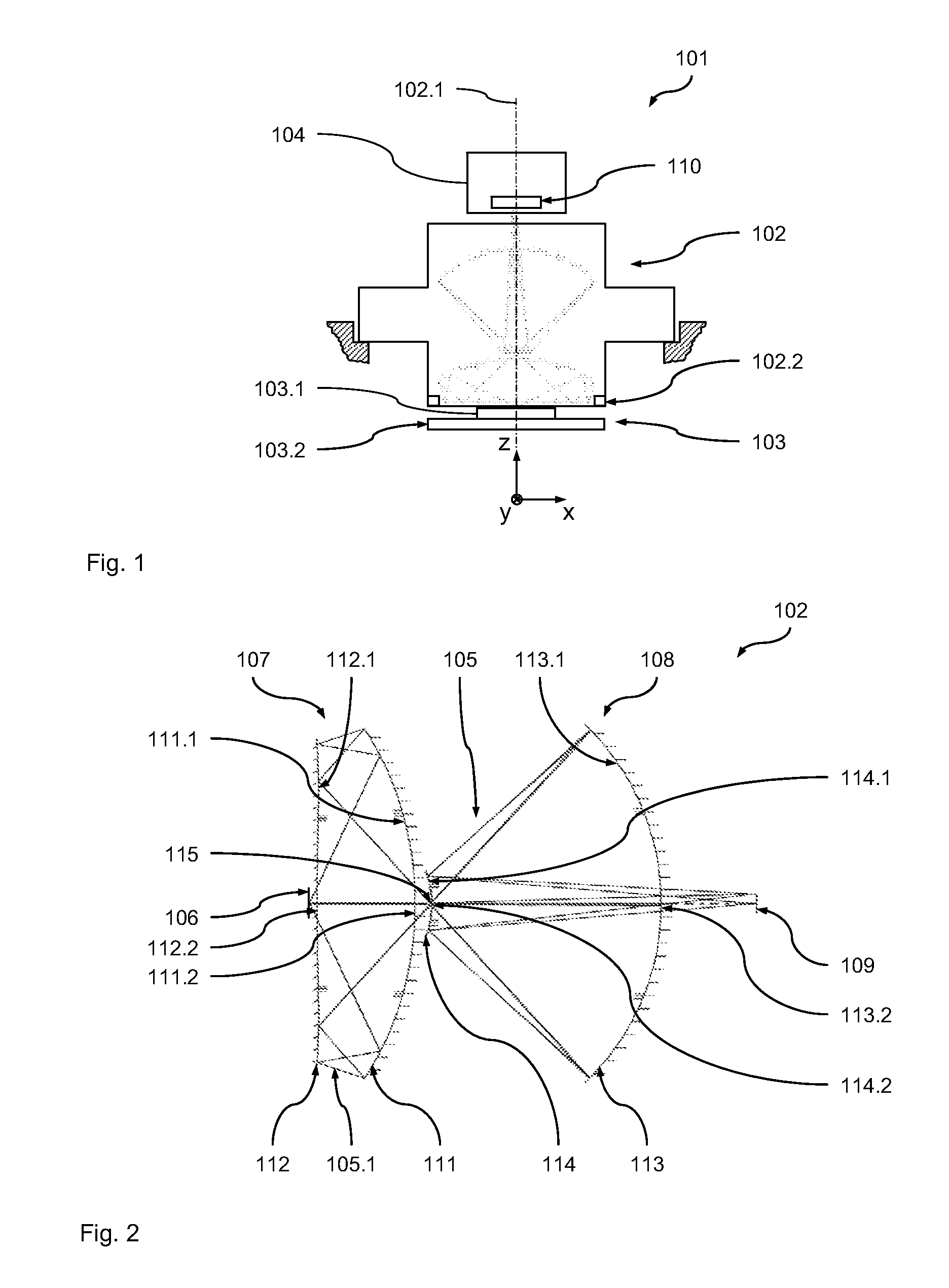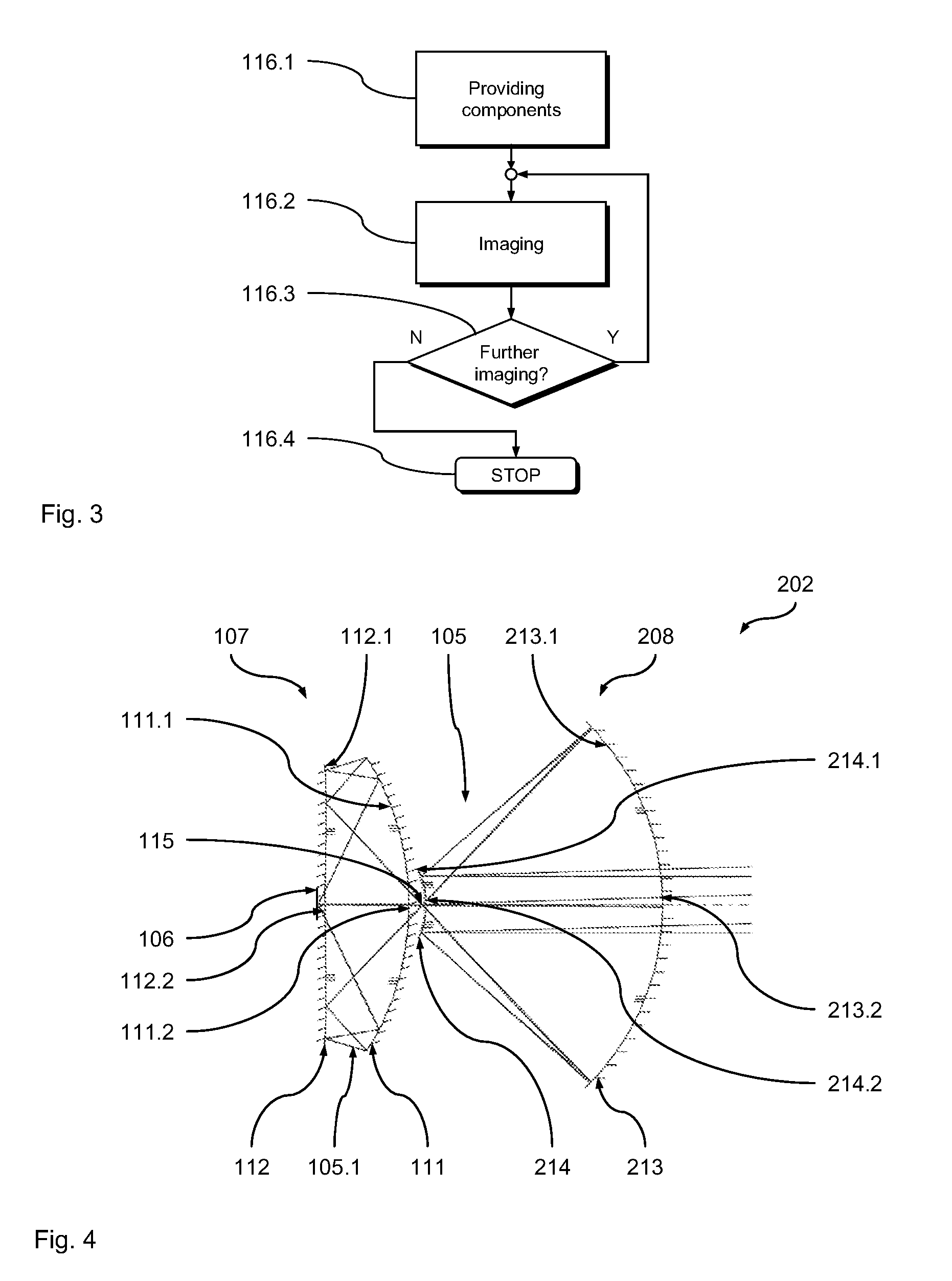Optical imaging device and imaging method for microscopy
a technology of optical imaging and imaging method, which is applied in the field of optical imaging device and imaging method for microscopy, can solve the problems of chromatic aberration, so-called achromatization of such imaging device comprising refractive optical elements, and the elimination of such chromatic aberration, and achieves the effect of reducing the number of aberrations, and high numerical apertur
- Summary
- Abstract
- Description
- Claims
- Application Information
AI Technical Summary
Benefits of technology
Problems solved by technology
Method used
Image
Examples
first embodiment
[0023]With reference to FIGS. 1 to 3, a preferred embodiment of the microscope 101 according to the invention with a preferred embodiment of the optical imaging device 102 according to the invention is described below.
[0024]In the present example, the microscope 101 is used to inspect the structures formed on a substrate 103.1 (which were produced for example via an optical process). However, with other variants of the invention, the microscope according to the invention can also be used for an imaging process in connection with arbitrary other applications, in particular the inspection of arbitrary other bodies, substrates, surfaces or liquids etc.
[0025]FIG. 1 shows a schematic representation of the microscope 101 which comprises an optical imaging device in the form of an objective 102 (with an optical axis 102.1 and illumination system 102.2), a substrate device 103 and an image recording device 104. The illumination system 102.2 illuminates (via a light guide device not shown in...
second embodiment
[0046]A further preferred embodiment of the optical imaging device according to the invention in the form of an objective 202 is described below with reference to FIGS. 1 and 4. The objective 202 can be used in the microscope 101 instead of the objective 102. The objective 202, in its basic structure and functionality, corresponds to the objective 102 from FIG. 2 so that merely the differences shall be discussed here. In particular, similar components carry the same reference numerals incremented by a value of 100. Unless specified otherwise below, with regard to the features of these components, reference is made expressly to the statements given above.
[0047]The sole difference of lens 202 from lens 102 is that the fourth optical element 214, on the one hand, has been modified in the design of the fourth optical surface 214.1 such that the image of a point on the object plane is formed on an image plane lying in infinity (not shown). Furthermore, the third optical element 213 is pr...
third embodiment
[0049]A further preferred embodiment of the optical imaging device according to the invention in the form of an objective 302 is described below with reference to FIGS. 1 and 5. The objective 302 can be used in the microscope 101 instead of the objective 102. The objective 302 corresponds in its fundamental structure and function to the objective 102 from FIG. 2, so that merely the differences shall be discussed here. In particular, similar components carry the same reference numerals incremented by a value of 200. Unless specified otherwise below, with regard to the features of these components, reference is made expressly to the statements above.
[0050]The main difference of the objective 302 from objective 102 is the design of the second optical element 312 lying spatially closest to the object plane 106. In the present example, the second optical element 312 is shown as a pronounced concave mirror with a high edge thickness (in the peripheral area of the optical element 312, the ...
PUM
 Login to View More
Login to View More Abstract
Description
Claims
Application Information
 Login to View More
Login to View More - R&D
- Intellectual Property
- Life Sciences
- Materials
- Tech Scout
- Unparalleled Data Quality
- Higher Quality Content
- 60% Fewer Hallucinations
Browse by: Latest US Patents, China's latest patents, Technical Efficacy Thesaurus, Application Domain, Technology Topic, Popular Technical Reports.
© 2025 PatSnap. All rights reserved.Legal|Privacy policy|Modern Slavery Act Transparency Statement|Sitemap|About US| Contact US: help@patsnap.com



